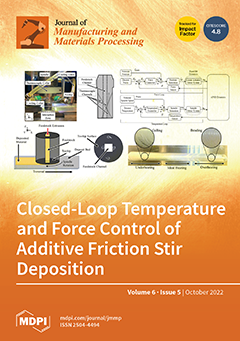Open AccessArticle
Process-Integrated Lubrication in Sheet Metal Forming
by
Roland Lachmayer, Bernd-Arno Behrens, Tobias Ehlers, Philipp Müller, Philipp Althaus, Marcus Oel, Ehsan Farahmand, Paul Christoph Gembarski, Hendrik Wester and Sven Hübner
Cited by 8 | Viewed by 2362
Abstract
The deep-drawability of a sheet metal blank is strongly influenced by the tribological conditions prevailing in a deep-drawing process. Therefore, new methods to influence the tribology represent an important research topic. In this work, the application of a process-integrated lubrication in a deep-drawing
[...] Read more.
The deep-drawability of a sheet metal blank is strongly influenced by the tribological conditions prevailing in a deep-drawing process. Therefore, new methods to influence the tribology represent an important research topic. In this work, the application of a process-integrated lubrication in a deep-drawing process is investigated. Most promising geometries of the lubrication channels and outlet openings are first identified by means of numerical simulation at the example of a demonstrator process. Cylindrical test specimens with the specified channel geometries are additively manufactured and installed in a strip drawing test stand. Additive manufacturing enables the possibility of manufacturing complex channel geometries which cannot be manufactured by conventional methods. A hydraulic metering device for conveying lubricant is connected to the cylindrical test specimens. Thus, hydraulically lubricated strip drawing tests are performed. The tests are evaluated according to the force curves and the fluid mechanical buildup of pressure cushion. The performance of process-integrated lubrication is thus analyzed and evaluated. By means of a coupled forming and SPH simulation, the lubrication channels could be optimally designed. From the practical tests, it could be achieved that the drawing force decreases up to 27% with pressure cushion build up. In this research, a hydraulic lubrication in the area of highest contact normal stresses is the most optimal process parameter regarding friction reduction.
Full article
►▼
Show Figures





